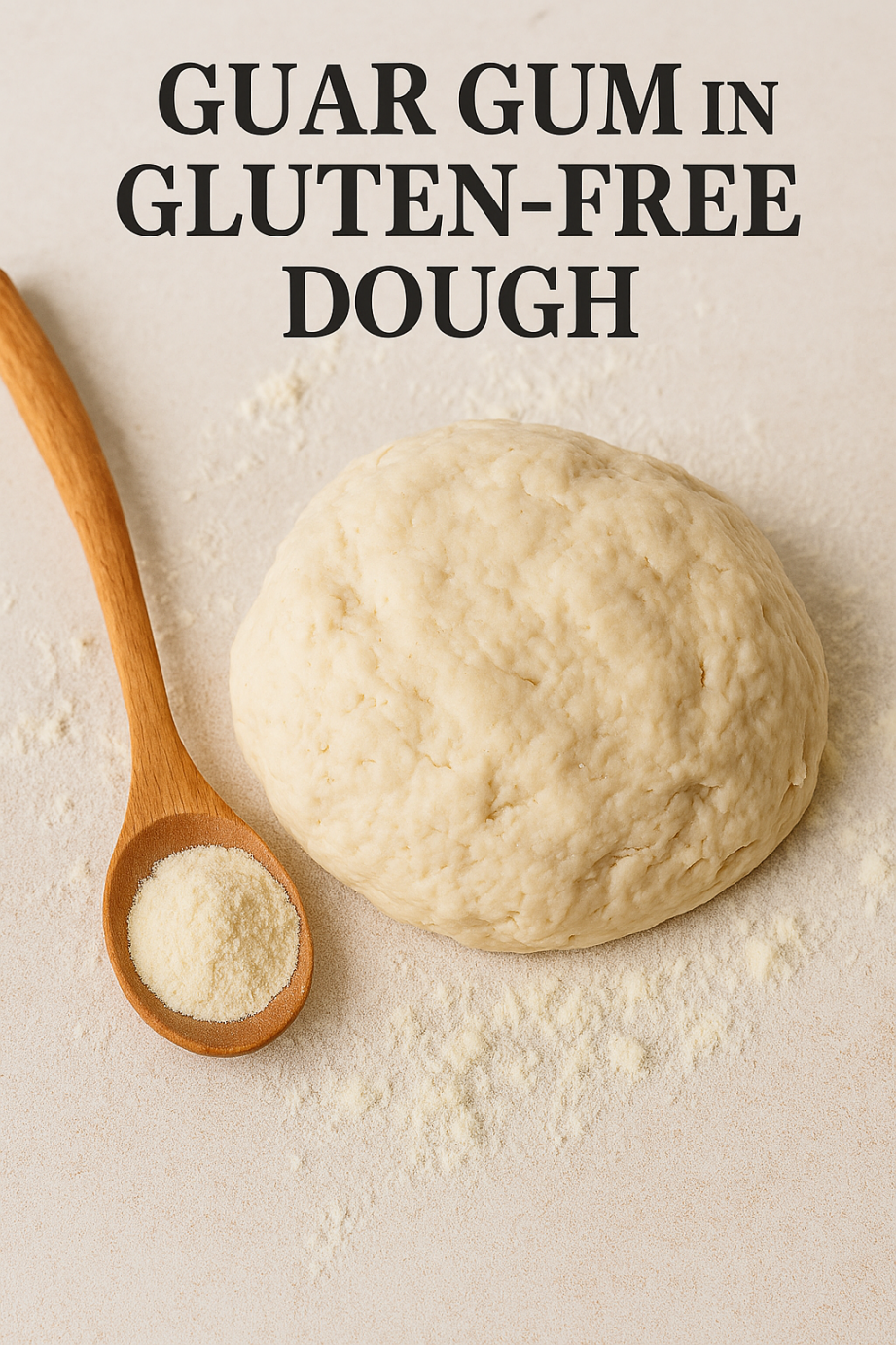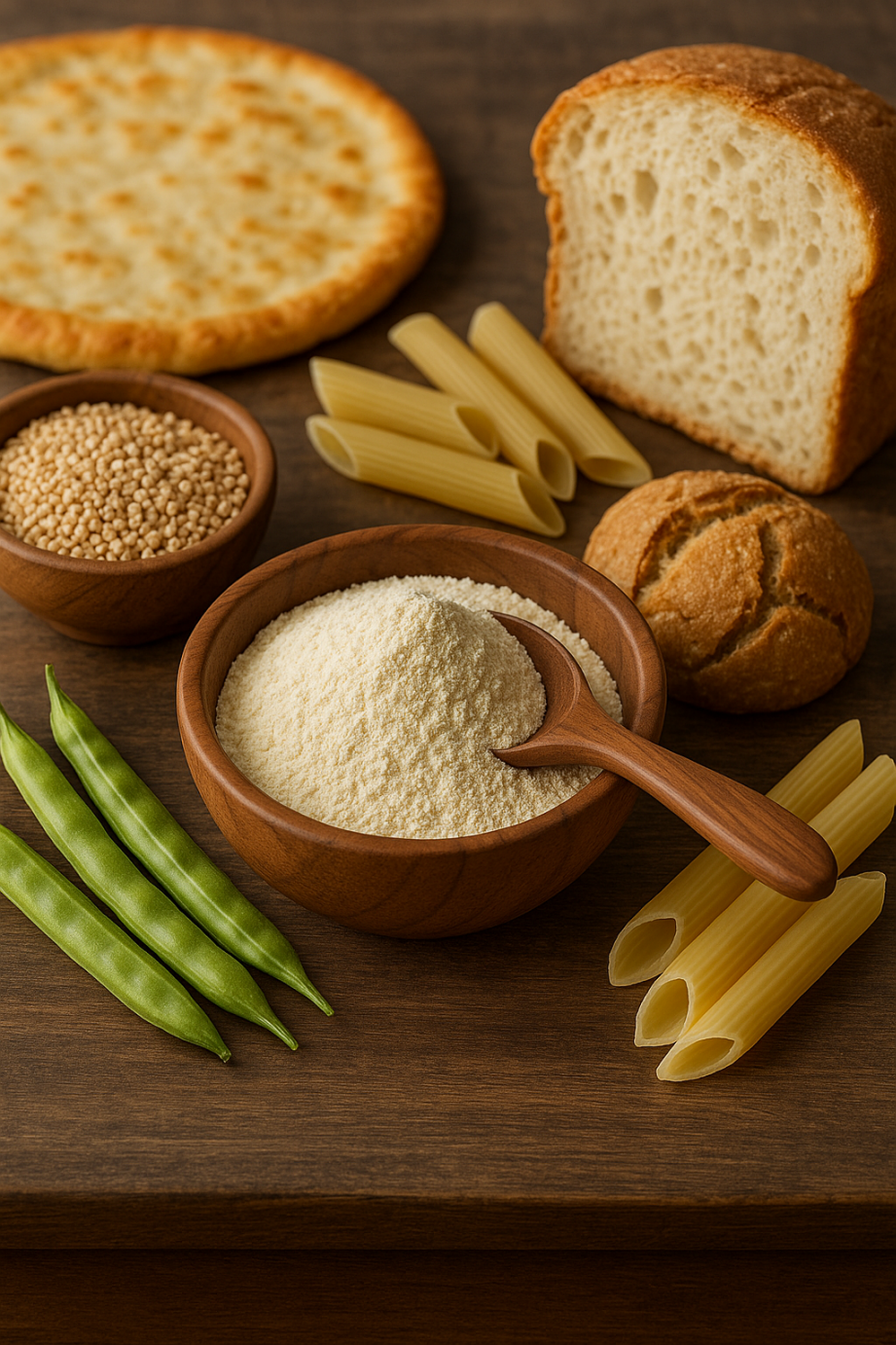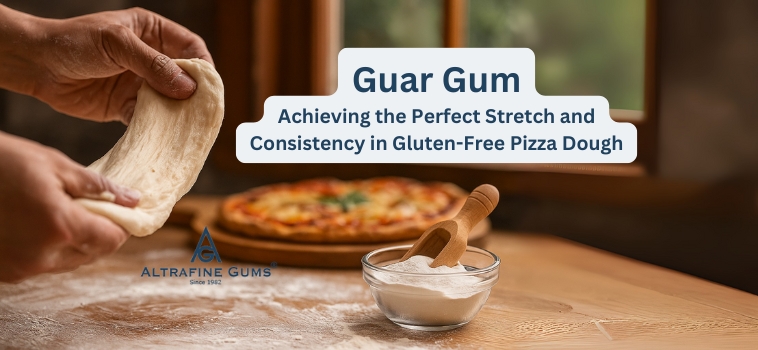When it comes to baking gluten-free pizza, achieving the right texture and elasticity can be challenging. Traditional pizza dough, made with wheat flour, relies on gluten to provide structure, stretch and consistency. For gluten-free pizza, however, the absence of gluten means that bakers must find alternative ingredients to mimic these qualities. Guar gum powder, is one such ingredient that has gained significant attention for its ability to improve the texture, elasticity and consistency of gluten-free pizza dough.
Guar gum offers various functional benefits, making it an essential ingredient in gluten-free baking. It helps improve the dough’s ability to stretch, hold moisture and maintain a desirable consistency. This article explores how guar gum addresses the challenges of gluten-free pizza dough production and how it contributes to achieving the perfect dough for pizza making.
Challenges of Gluten-Free Pizza Dough Production
Issues with Texture, Elasticity and Consistency in Gluten-Free Pizza Dough
One of the most significant challenges when producing gluten-free pizza dough is replicating the stretch and elasticity that gluten provides in traditional dough. Gluten acts as a natural binder, holding the dough together and allowing it to stretch without breaking. In gluten-free pizza dough, the absence of gluten often leads to a dough that is crumbly, dry or difficult to handle. Additionally, the lack of elasticity can make it challenging to stretch the dough to the desired thinness for a pizza base.
Another issue in gluten-free pizza dough is achieving the right consistency. Without gluten, gluten-free dough tends to be more delicate and often lacks the chewiness or smooth texture that people expect from pizza dough. These challenges can result in dough that is difficult to work with, does not rise well or fails to hold together during baking.
How Guar Gum Addresses These Challenges by Improving Stretch and Texture?
Guar gum is highly effective in solving these problems. As a binding agent, guar gum powder helps hold the ingredients together, improving the dough’s ability to stretch and preventing it from becoming crumbly. It works by absorbing water and forming a gel-like texture that mimics the elasticity of gluten. This allows gluten-free pizza dough to be more workable, stretchable and less prone to tearing.
Additionally, guar gum improves the texture of the dough, providing a smoother, more consistent result. The added viscosity from guar gum for pizza dough helps retain moisture, making the dough more pliable and less likely to dry out during the preparation process. These benefits make guar gum powder an essential ingredient in achieving the desired texture, consistency and stretchability of gluten-free pizza dough.
The Science Behind Guar Gum’s Role in Gluten-Free Dough
Viscosity-Building Properties of Guar Gum in Gluten-Free Formulations
The primary way guar gum works in gluten-free pizza dough is by building viscosity. When mixed with water, guar gum powder forms a thick, gel-like substance that adds structure and texture to the dough. The viscosity created by guar gum powder helps bind the ingredients, ensuring the dough holds together and maintains its shape during stretching and baking.
This viscosity-building ability is especially important in gluten-free pizza dough, as it helps compensate for the absence of gluten. The thickness provided by guar gum makes the dough easier to handle and shape, which is crucial for pizza preparation. Furthermore, the viscosity of the dough contributes to the smooth and even texture that people expect from pizza crust.
How Guar Gum Helps Retain Moisture and Enhances Dough Elasticity?
Another key benefit of guar gum in gluten-free pizza dough is its ability to retain moisture. When added to the dough, guar gum acts as a moisture-retaining agent, preventing the dough from drying out during the mixing and resting processes. This is important because gluten-free dough can often become dry and brittle without adequate moisture retention.

By retaining moisture, guar gum powder helps improve the elasticity of the dough, making it more stretchable and less prone to breaking. The increased moisture content also helps the dough rise better, leading to a fluffier and more enjoyable pizza crust. As a result, guar gum not only enhances texture but also ensures that the dough remains fresh and flexible, even after baking.
Application of Guar Gum in Gluten-Free Pizza Dough Manufacturing
How Guar Gum is Integrated into Pizza Dough Recipes for Optimal Performance?
In pizza dough, guar gum is typically integrated as part of the dry ingredients during the initial mixing process. It is usually added to the flour blend, which may include rice flour, tapioca flour or other gluten-free flours. When mixed with water, guar gum powder helps improve the dough’s consistency, allowing it to hold together more effectively and making it easier to work with.
The recommended amount of guar gum for gluten-free pizza dough usually varies on the total flour weight, depending on the desired texture and stretchability of the dough. Guar gum should be evenly distributed throughout the flour blend to ensure uniform hydration and consistent dough performance.
The Benefits of Guar Gum in Both Small-Scale and Large-Scale Production
Guar gum is highly versatile and beneficial in both small-scale and large-scale pizza dough production. In small-scale production, such as home baking or artisanal pizza making, guar gum powder allows for more consistent results, especially in recipes that are not as precisely measured. Its ability to improve dough stretch and texture makes it a popular choice for home bakers who want to achieve professional-quality gluten-free pizza crusts.
In large-scale production, guar gum for pizza dough becomes even more crucial. It helps ensure consistency across batches, ensuring that the dough behaves the same way every time, regardless of production volume. Additionally, the use of guar gum in large-scale operations can reduce the need for expensive or complex equipment by simplifying the dough-making process, making it easier for manufacturers to create high-quality gluten-free dough at scale.
Consumer Demand for Gluten-Free Pizza and the Role of Guar Gum
Rising Popularity of Gluten-Free Diets and the Market Demand for Gluten-Free Foods
The demand for gluten-free products, has grown significantly over the past decade, not only due to medical conditions but also because of increasing consumer awareness about gluten sensitivities and health trends. As more people adopt gluten-free diets, the need for high-quality, delicious gluten-free pizza dough has become more pressing.
This growing market presents an opportunity for manufacturers to develop better, more accessible gluten-free pizza options that do not compromise on texture or taste. Guar gum plays a pivotal role in this development by enabling manufacturers to produce dough that meets consumer expectations for stretch, consistency and taste. As a result, guar gum for gluten-free pizza has become a must-have ingredient in meeting this growing demand.
How Guar Gum Contributes to the Growing Gluten-Free Food Trend
As the gluten-free food trend continues to rise, guar gum is playing an increasingly important role in helping manufacturers meet the high standards of quality and texture that consumers expect from gluten-free pizza. By enhancing the elasticity and stretch of the dough, guar gum allows pizza makers to create a more authentic pizza experience for those who require or prefer gluten-free options.

In addition to improving texture and consistency, guar gum contributes to the overall quality of the pizza, ensuring that the dough is both easy to handle and retains its freshness during storage. As more people turn to gluten-free pizza, guar gum will continue to be a key ingredient in the creation of high-quality, delicious gluten-free pizza crusts.
Best Practices for Using Guar Gum in Gluten-Free Pizza Dough
Recommended Concentrations and Formulations for Consistent Results
To achieve the best results, it’s important to use the correct concentration. Using too much guar gum can result in a dough that is too thick or overly elastic, which can make it difficult to stretch.It’s important to thoroughly mix into the dry ingredients to ensure that it is evenly distributed. This will help achieve uniform hydration and consistency throughout the dough.
Key Considerations in the Dough-Making Process for Pizza Manufacturers
When using guar gum in gluten-free pizza dough, it’s essential to consider the hydration level of the dough. Since guar gum helps retain moisture, it’s important to adjust the water content in the dough recipe to avoid making it too wet. Additionally, the dough should be allowed to rest after mixing to give the time to hydrate fully and achieve its thickening effects.
Manufacturers should also be aware of the rest time during the dough-making process. Allowing the dough to rest helps activate the guar gum, ensuring optimal stretch and consistency. The dough should also be handled gently to prevent it from becoming too tough or sticky.
Conclusion
Altrafine Gums, as a leading manufacturer of Guar Gum is a powerful ingredient in achieving the perfect stretch, consistency and texture in gluten-free pizza dough. Its ability to act as a binding agent and improve elasticity makes it an invaluable addition to gluten-free baking, allowing manufacturers to create high-quality, flexible dough that mimics the characteristics of traditional pizza dough. As the demand for gluten-free products continues to grow, guar gum powder will remain essential in meeting consumer expectations for delicious, well-textured pizza. Whether in small-scale or large-scale production, guar gum is a key player in revolutionizing the gluten-free pizza dough market.

CEO, Altrafine Gums
With over Four decades of expertise in the natural gums and hydrocolloids industry, Ajit Patel leads Altrafine Gums, a globally recognized manufacturer and exporter of Guar Gum Powder, Cassia Tora Powder (Cassia Gum Powder) and other Hydrocolloids. Under his visionary leadership, the company has built a strong reputation for quality, innovation, and reliability across the food, feed, pet feed, pharmaceutical, mining, oil drilling and cosmetic sectors.
Altrafine Gums has been serving global industries for decades with a focus on sustainable sourcing, research-driven production, and stringent quality control. Its wide product portfolio includes Guar Gum Powder, Cassia Tora Powder (Cassia Gum Powder) and other plant-based hydrocolloids that serve as key functional ingredients in diverse applications.
Ajit Patel’s commitment to excellence ensures that every product from Altrafine meets international standards of performance and purity. He is passionate about advancing the global reach of Indian hydrocolloids, fostering customer trust, and promoting eco-friendly, science-backed solutions that enhance product formulation and performance worldwide.

